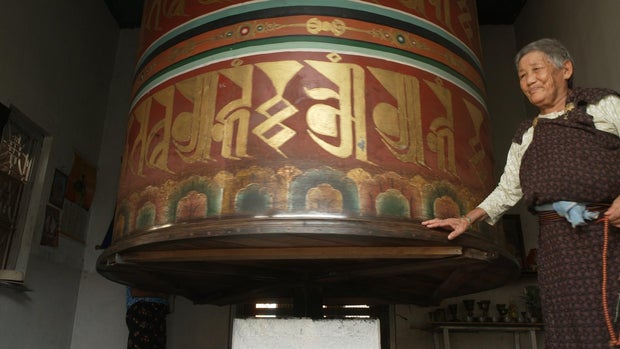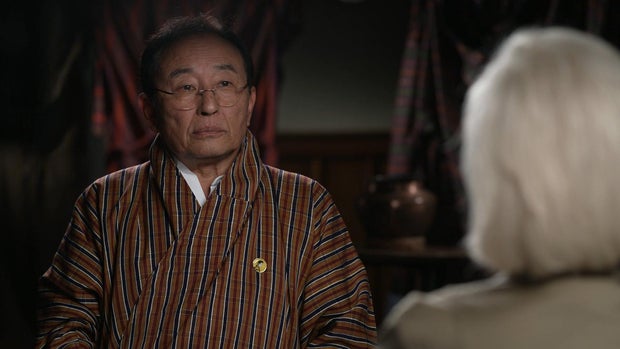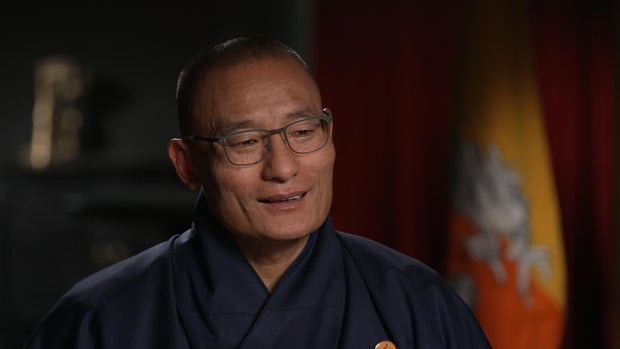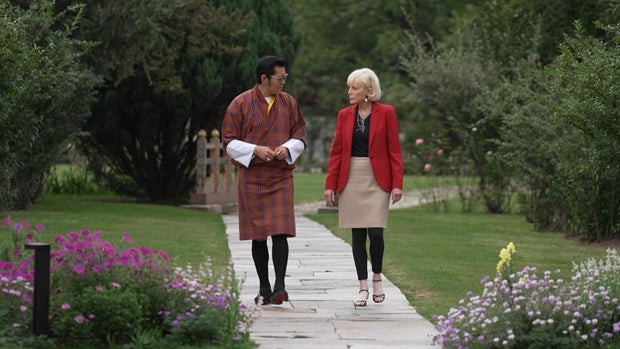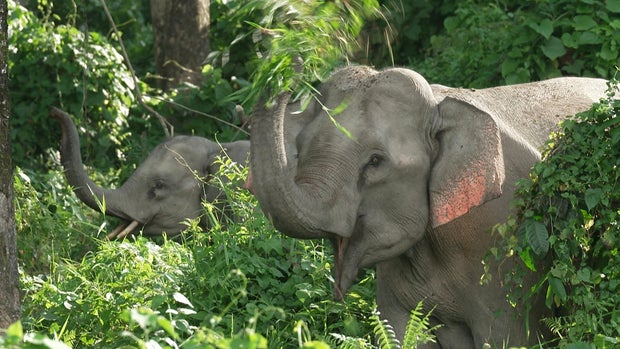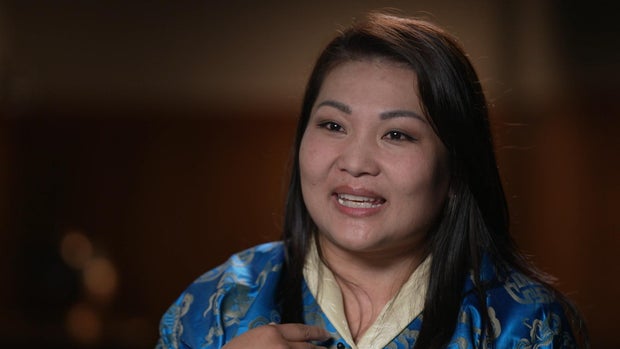CBS News
Teen sues high school after science teacher brought swords to class and instructed students to fight

A New Mexico school, its vice principal, and a teacher there are the subject of a lawsuit alleging that the teacher brought real swords into her science classroom and instructed students to fight with them, causing one student to become badly injured.
The lawsuit is being brought on behalf of the student, identified only as N.S., by her grandparents and permanent guardians, Arnold and Judy Gachupin. According to the lawsuit, which was filed on Feb. 23, N.S. was a 16-year-old sophomore at Albuquerque Public Schools’ Volcano Vista High School at the time.
The incident began when the teacher, identified in the lawsuit as Loviata Mitchell, brought two swords into the school on May 2, 2022. She allegedly hid them from students, security staff and other school personnel, until the class that N.S. was in. At that point, Mitchell allegedly announced that she had “surprise” for her students, according to the lawsuit, and revealed the two swords. One was a katana-style sword with a “long, curved blade and sharp edge,” according to the lawsuit, and the second was a rapier-style sword. Mitchell, according to the lawsuit, told the students the swords were props.
After bringing out the weapons, Mitchell allegedly instructed the students to rearrange their desks and create a space in the middle of the classroom for pairs of students to fight. The fights were timed with a two-minute timer displayed on the classroom’s projector, and filmed and photographed by other students, including N.S. Video footage of the fights was included in the lawsuit, and “shows Ms. Mitchell looking on approvingly.” Mitchell had no certifications or experience in sword-fighting, the lawsuit said.
Lawsuit photo
N.S. was then called to fight, but shortly after the bout began, she was struck across her right forearm, wrist and hand by the katana-style sword, causing a “large and deep laceration” that began to bleed profusely, according to the lawsuit. Mitchell allegedly stated “I’m in trouble!” after the injury occurred, and ordered students to delete video recordings of the fights and to not tell anyone about them.
Mitchell also allegedly delayed calling for help. N.S.’s grandfather was contacted about 20 minutes after the injury was sustained, and because Mitchell could not figure out how to dial the nurse’s office, it wasn’t until N.S. “began to feel nauseous and weak from blood loss” that another student left the room to get medical assistance. About 30 minutes after N.S. was cut, 911 was called and N.S. was brought to the hospital.
The lawsuit described the injury as a “gaping wound” that resulted in injuries to nerves and tendons in N.S.’s dominant hand. The nerves and tendons remain damaged, despite surgery on the area, and “cause ongoing daily pain,” according to the lawsuit, and make it difficult or impossible for N.S. to perform “many basic daily tasks” including preparing food, fastening buttons and zippers, and more. She continues to undergo occupational and physical therapy, the lawsuit said, but her dominant hand remains significantly weaker than her non-dominant hand. The teen was also diagnosed with post-traumatic stress disorder, the lawsuit said.
Lawsuit photo
“Because of the injury, N.S. has become withdrawn and depressed; as a result, the Plaintiffs no longer enjoy as close of a relationship with their granddaughter,” the lawsuit said. “N.S. is not the same emotionally as she was before the injury, and this has affected the Plaintiffs’ relationship with N.S., their quality of life, and their home environment.”
The lawsuit also alleges that the school attempted to cover up the incident, with the assistant principal, identified as Manuel Alzaga, filling out an official accident report that described the swords a prop brought in to teach a students a lesson “on metal and melding.” The incident report noted that N.S. had been injured, but said that the injury did not violate school rules, despite the school and state both prohibiting deadly weapons, which would include swords, from being brought onto school campuses. The lawsuit argued that this was an attempt to deflect liability away from Mitchell.
The lawsuit is seeking compensatory and punitive damages, as well as attorneys’ fees, costs and other relief. The school told CBS News that it could not comment on the allegations, citing a policy against commenting on pending litigation.
According to the lawsuit, Mitchell is no longer a teacher at Volcano Vista High School.
CBS News
How an Australian drama school helped shape talent flooding Hollywood

They may have perfected American accents, but some of the biggest names in Hollywood are Australian.
Many of the Australian actors, directors, writers and crew now working in Hollywood started learning their craft at NIDA, the National Institute of Dramatic Arts.
John Clark, NIDA’s director for 35 years, set a goal from the start: unlocking a distinct, Australian mode of acting that combined the theater of London with Hollywood gloss, but still allowed Australia’s national characteristics to shine through.
“They are playing characters with such conviction and with such truth,” Clark, now 92, said. “Without what Australians would call decoration.”
The who’s who of NIDA
Sarah Snook, fresh off her Emmy-winning breakthrough role as Shiv Roy in “Succession” and now playing all 26 roles in a staging of “The Picture of Dorian Gray,” learned to mask her Australian accent at NIDA.
She was class of 2008, one of only 24 admitted that year. The acceptance rate at the school is barely 2% — Hugh Jackman and Naomi Watts were among those declined. Graduates include Mel Gibson, Cate Blanchett, director Baz Luhrmann and his wife, four-time Oscar-winning costume and production designer Catherine Martin.
60 Minutes
Luhrmann still leans on his NIDA training.
“I do remember one thing. And I think it’s sort of an Australian attitude, which is, ‘Don’t wait for permission to be told that you can act,'” Luhrmann said.
The growth of the Australian acting and directing scene
Luhrmann was at NIDA when he devised “Strictly Ballroom.” Within a few years, he’d turned the play into a cult hit film with an all Aussie cast and crew. That was in 1992, and soon after, Australian talent started filtering out. Now Australians populate IMDB pages and call sheets, bringing heroes and villains to the big screen, earning top billings and top awards. Australians have become to Hollywood what Kenyans are to marathoning: wildly overrepresented.
“It’s got to a point where there are so many Australian performers and actors, behind the screen, I mean, screenplay writing and directing, but particularly with actors, that even I have to be told, ‘Oh, you know, X is Australian.’ I mean, ‘Oh, I didn’t know that,'” Luhrmann said. “Because they are really everywhere. Now, NIDA was a really big part of that because I think it kind of set the culture and set the attitude.”
60 Minutes
Luhrmann believes the “don’t wait for permission” attitude NIDA instilled in its initial graduates spilled out into the larger sense of what it is to be a performer in Australia.
“You know, just throwing yourself off the cliff and flying,” he said.
Other names out of Australia are Margot Robbie, Chris Hemsworth, Toni Collette and Geoffrey Rush.
Australian theater and soap operas have played a role in the surge, helping actors sharpen their skills and in some cases, launch their careers.
“Australia’s got great training grounds for international work,” Sarah Snook said. “There’s a way you can test yourself in Australia. And you can fail safely in a way.”
Bringing the Australian ethos to Hollywood
Snook grew up as a typical Aussie free range kid. She’d ride her bike around a national park in southern Australia that was home to kangaroos. Those experiences and the self-reliance it developed have helped her career.
“They build your character, so that you can play other characters,” she said.
60 Minutes
Australians are also known in the entertainment industry for taking the work more seriously than they take themselves.
“There is a bit of an understanding that…it’s all oftentimes smoke and mirrors. And it’s fun. And it’s a game,” Snook said. “It is profound in some ways, but it’s also silly. Like Chris Hemsworth has got a great tongue and cheek sort of attitude about it all…And also Baz Luhrmann, with all, you know, his films tend to have a bit of [a] little cheek or a wink to the audience.”
And, Luhrmann believes the remoteness of Australia is a blessing.
“The one thing everyone agrees about with Australia is that it’s far, far away,” he said. “And I think that we still think that the idea of being either in a movie or in a play on Broadway or in a television show in Hollywood is still a romantic notion. It’s still a privilege. It isn’t a job. It’s a dream.”
CBS News
Bhutan has made happiness a national priority. So why are so many citizens leaving the country?

It sounds like something out of a fairytale.. a beautiful, remote land, with an enlightened king adored by his subjects.. a place with tall mountains, lush forests, flowing rivers and clean air.. where happiness is valued above all else.
We’re describing the tiny kingdom of Bhutan, wedged between China and India in the Himalayan Mountains. A place so fiercely protective of its unique Buddhist culture that for a long time it sealed itself off… didn’t admit tourists until the 1970s and didn’t introduce television until 1999. A place that charted its own path to development when its king coined the phrase “Gross National Happiness” and made maximizing it the nation’s top priority.
But when a fairytale kingdom meets the modern world, a storybook ending is far from certain.
Sunrise over Bhutan’s Dochula Pass.. a place so calm.. so transcendent.. you feel you’ve landed in another time.
Buddhism is the national religion here. We found Bhutanese, especially older men and women, spending hours spinning prayer wheels full of Buddhist scriptures… and prayer flags fluttering on hillsides and in forests, turning nature itself into a shrine. Bhutan’s capital city, Thimphu, still has no traffic lights. The old and the new mingle in peaceful coexistence here, even on the nation’s roads.
60 Minutes
Dasho Kinley Dorji: Bhutan’s story, in one word, is survival.
Dasho Kinley Dorji ran Bhutan’s first newspaper, then served as a government minister.
Dasho Kinley Dorji: We were and still are a very nervous population, between India and China. In the old days, what Bhutan did was we hid in the mountains.
Lesley Stahl: You hid from these two giants–
Dasho Kinley Dorji: Yes.
Lesley Stahl: You were afraid they’d–
Dasho Kinley Dorji: Yes.
Lesley Stahl: –gobble-you-up?
Dasho Kinley Dorji: Oh, yes, yes. Because we don’t have military might or economic force. So Bhutan’s strength was going to be our identity: To be different from everyone around us. We wear different clothes, you know, we construct our buildings in our traditional architecture, an identity based on our culture, that was our strength.
And that culture remains strong.. thousands of Bhutanese gather for seasonal religious festivals, with songs in the national language, Dzongkha, and centuries-old dances and costumes. This is not a tourist-focused spectacle.. though foreigners are welcome. This is clearly for the Bhutanese, who come dressed in their finest.
Lesley Stahl: Tell us about what you are wearing. Because this is the traditional dress for a man.
Dasho Kinley Dorji: My wife joked and said, “It’s the men who wear the skirts in this country,” (laugh) showing our knees. This is called a “gho.” And it’s colorful because it’s all woven here using natural dye.
Lesley Stahl: Very old-fashioned.
Dasho Kinley Dorji: We came to realize that, you know, that what we had in the past, what is old, is actually very valuable.
60 Minutes
Ghos also double as athletic wear for Bhutan’s national sport — archery. They’re using traditional bows and arrows made of bamboo.. shooting at a target a football field and a half away.
Rabsel Dorji: Oh, he’s just hit. He’s just hit. (clapping) So what you’re gonna see is the two teams dancing now. (singing)
Lesley Stahl: They dance?
Rabsel Dorji: And they dance and they sing.
Rabsel Dorji, who once worked at the UN, was a teenager when television came to Bhutan 25 years ago.
Rabsel Dorji: I remember fixing the antenna at my house for my mom to watch. [chuckles]
Lesley Stahl: I wonder how rapidly change has come here. It– it’s almost head spinning.
Rabsel Dorji: My father, my late father, when he was growing up in the ’60s and ’70s, Bhutan was– there was no roads in the country. He had to travel for two, three days on horseback to get to school.
Bhutan was, and is today, largely a subsistence agricultural society, where many families still live in multigenerational farmhouses. The country was unified by the man who became its first king in 1907. His sons and grandsons, who Bhutanese refer to as the 2nd, 3rd, 4th, and today 5th kings, have reigned since. But it was the 4th king who as a young, newly-crowned ruler in the 1970s, really set Bhutan on its unique path to modernity. He was flying home from a summit of non-aligned nations in Cuba, and landed at an airport in India, since Bhutan still didn’t have one.
Dasho Kinley Dorji: Indian journalists met him at the airport, and the first question was, “We are– Bhutan is our closest neighbor. We know nothing about Bhutan: For example, what’s your gross national product?” And the king said, “Actually, in Bhutan, gross national happiness is much more important to us than gross national product.”
Lesley Stahl: It just came out of–
Dasho Kinley Dorji: Yes.
Lesley Stahl: –his mouth–
Dasho Kinley Dorji: Yes.
Lesley Stahl: –like that?
Dasho Kinley Dorji: So– sexy headline.
Lesley Stahl: (chuckle)
Sexy headline.. that got international attention. The UN convened a special meeting in 2012 and adopted a resolution urging others to follow Bhutan’s lead. and in Bhutan, it became the primary responsibility of government – led today by Prime Minister Tshering Tobgay.
60 Minutes
Lesley Stahl: Explain Gross National Happiness. What– what is it?
Tshering Tobgay: In the last 300 years, we’ve been obsessed with growth. Gross National Happiness acknowledges that economic growth is important, but that growth must be sustainable. It must be balanced by the preservation of our unique culture. People matter. Our happiness, our well-being matters. Everything should serve that.
So every five years, surveyors travel throughout Bhutan measuring the nation’s happiness. They ask about education level, salary, material possessions.. Do you have negative thoughts? Positive thoughts? How much time do you spend working? Praying? Sleeping? The results are analyzed and factored into public policy.
Lesley Stahl: But people here don’t walk around smiling and laughing all the time. They look to me li– like people everywhere. (laugh)
Tshering Tobgay: Gross National Happiness does not directly equate to happiness in the moment. One happiness is fleeting, it is emotion, it is joy. The other is contentment, to be happy with life, to be happy with oneself. And that’s what Gross National Happiness is all about.
It’s also about nature. By law at least 60% of the country must remain under forest cover, and with most of its energy coming from hydroelectric power, Bhutan was the first and today one of the only countries in the world to be carbon negative. It earns foreign revenue selling excess hydropower to India — and from tourism.. but there are limits.
Lesley Stahl: You have all these gorgeous mountains, but you don’t allow mountain-climbing?
Dasho Kinley Dorji: Yes.
Lesley Stahl: That really surprised me: Why not?
Dasho Kinley Dorji: For a Bhutanese, it’s very easy to understand: You know, the mountains are sacred.
Lesley Stahl: The mountains are sacred?
Dasho Kinley Dorji: Sacred, home of deities. You don’t climb all over it– because it’s sacred. Nature is not something to be “conquered.” You know, it’s something to be respected.
Little boy making presentation: Recycling, separating non-degradable and degradable waste
School is taught in English, and it’s free, as is health care — major accomplishments in a country still considered a developing nation. Oh, and there’s one more thing.. that king who introduced Gross National Happiness… 25 years later decided that happiness required another big change — the right to elect a parliament and prime minister.
60 Minutes
Tshering Tobgay: Bhutan is the only country where democracy was introduced in a time of peace and stability, where democracy was literally gifted, imposed on the people, not just gifted, because the people didn’t want it.
Lesley Stahl: No one was clamoring for it. It wasn’t the–
Dasho Kinley Dorji: Yes.
Lesley Stahl: –French Revolution– there was no revolution. He just decided.
Dasho Kinley Dorji: I traveled with the king—
As a reporter, Kinley Dorji covered the king’s travels to villages all over Bhutan.
Dasho Kinley Dorji: It was called “consultations.” And the only consultation I saw was people begging him not to do this–
Lesley Stahl: Hunh.
Dasho Kinley Dorji: –you know? And that’s–
Lesley Stahl: And so people did not want democracy?
Dasho Kinley Dorji: Yes. Yes. And they’re pleading, and very–
Lesley Stahl: Oh, wow.
Dasho Kinley Dorji: –very articulate arguments on why, because when they looked around the world, their horizon was India, Nepal, Bangladesh, Pakistan: Democracy.
Lesley Stahl: Well–
Dasho Kinley Dorji: Which is really synonymous with– violence, with corruption. So they said, “No, thank you. We– we didn’t really– we (laugh) don’t really need that. We are fine.”
Lesley Stahl: He defied the people and imposed democracy.
Dasho Kinley Dorji: But he– you couldn’t argue with him. He had arguments like, “You leave this small country in the hands of one man, who’s chosen by birth and not by merit. Small country’s finished. One day, we’ll have a bad king.
And with that, the 4th king abdicated at just 51, passing the crown to his 26-year-old son, the 5th and current king. Bhutanese headed to the polls for the first time ever. The result is hard to wrap a Western head around.. a democracy where the king is universally adored — that’s him swearing in the prime minister — and the two work together as partners. Quite the happily ever after ending… except this would-be fairytale has an unexpected plot twist..young Bhutanese are leaving the country in record numbers.
60 Minutes
Tshering Tobgay: This is a very difficult situation for Bhutan.
Lesley Stahl: You called it existential.
Tshering Tobgay: It is an existential crisis.
So how did Bhutan, a country that prioritizes its people’s happiness, find itself with so many of them leaving? Well it started with COVID, which hit Bhutan’s economy hard, shutting down tourism, and recovery has been slow. Many Bhutanese — with their excellent English – found higher-paying jobs in Australia, even doing menial labor. Word spread on social media, and now a devastating 9% of the country’s population has left.. most of them young.
Bhutan’s government has mobilized, with the king launching a bold, high-stakes plan, and something of an experiment.. can he create a place where development — and wealth — can coexist with sacred values?
Namgay Zam: It’s a lot of people with skills who are leaving, right, people in my age group.
Namgay Zam is a journalist, who used to anchor Bhutan’s nightly newscast.
Namgay Zam: All of my friends who are journalists, they are all outside. There are just two of us left in the country. Editors, graphic designers– sound people. Yes, Lesley. Yes.
Lesley Stahl: They’ve left the country?
Namgay Zam: They’ve left the country.
Outside Bhutan’s airport, we saw what looked like a sort of picnic, but was actually a goodbye.
Rabsel Dorji: The whole family tends to go to the airport.
Often, Rabsel Dorji told us, several generations.
Rabsel Dorji: We’re very close to our families. And so when someone leaves so far away, they don’t know when the next meal together in the family will be.
— plane on runway, pans to family waving above —
Rabsel Dorji: There’s another vantage point where you can see the plane take off. And so many of the family members will wave them goodbye and see them off. That’s a very emotional experience.
60 Minutes
Lesley Stahl: So many of your people are leaving– I– I have to ask you this, has Gross National Happiness been a failure?
Tshering Tobgay: Gross National Happiness has succeeded.
Lesley Stahl: But if people are leaving.
Tshering Tobgay: I’m 58 years old, in my generation Bhutan has transformed from a Medieval society, literally with no roads, no clean drinking water, life expectancy in the 40s, very few schools– to what you see today We have free education, free healthcare, where life expectancy is now crossing 70 years old. Where our economy, while it is still small, has been growing in the last 30 years. It’s been growing on average of– of about 6%, and it’s growing without destroying, undermining our culture. So by these measurements, I would say Gross National Happiness has succeeded. As a matter of fact, perhaps it has succeeded beyond our wildest dreams.
Meaning he believes it’s ironically the success of Gross National Happiness that has made bhutanese young people sought after abroad.
Tshering Tobgay: We have to lure them back, and the only way to lure them back is by good, well-paying jobs.
So he’s trying to attract more business and tourists to Bhutan, highlighting landmarks like this centuries-old suspension bridge, part of an ancient 250-mile trail from one end of the country to the other..now restored to welcome trekking tourists.
And near the bridge, at twilight, one of the most beautiful buildings we’d ever seen, built in the 1600s. But tourism can only do so much, and Bhutan’s king knows it. So while he never gives on-camera interviews..he did grant us a royal audience to share what might be called an enlightened hail mary. He’s decided to create a new city in southern Bhutan with different rules from the rest of the country.. an attempt at a new model of robust economic development, still true to Bhutanese values. He’s calling it the Gelephu Mindfulness City. And to design it, he turned to Danish architect Bjarke Ingles.
Bjarke Ingels: There’s a real reason why you do something out of the ordinary.
Ingels is known for his innovative buildings, like this New York City skyscraper.
Lesley Stahl: What’s the biggest challenge here?
60 Minutes
Bjarke Ingels: The big question is, can you create a space for economic activity and the future without sacrificing the values and cultural riches that they have today?
Bjarke Ingels: You have 34 rivers.
As Ingels showed us in these renderings, the new city will have neighborhoods nested between the area’s many rivers, connected by a series of unusual bridges.
Bjarke Ingels: We got the idea that the bridges could be like the public buildings.
Lesley Stahl: This is a bridge?
Bjarke Ingels: This is a bridge that is also a kind of Buddhist center.
Lesley Stahl: Oh,
Bjarke Ingels: This is a health care bridge. It actually has, health care facilities, on either side of the road. This is a university bridge.
All built with local materials. This will be the downtown. No skyscrapers.
To see the site, we flew about an hour south of the capitol, leaving behind those sacred Himalayan peaks, for Bhutan’s tropical lowlands, and we climbed to a lookout, where there wasn’t much to see..
Lesley Stahl: This is empty right now. You’re going to have a whole new city here.
Dr. Lotay Tshering: We are looking at a small piece of the city.
Our guide was Dr. Lotay Tshering, a former prime minister who the king has tapped to govern the new city. He told us it will be built in phases over the next two decades, with no polluting industries allowed.
Dr. Lotay Tshering: We have lots of wildlife. Very, very rich wildlife. The most prevalent are the elephants.
Lesley Stahl: You have elephants?
Dr. Lotay Tshering: Yes.
60 Minutes
And sure enough, we spotted this family a few hours later, just off the side of the road. As habitat shrinks elsewhere, more elephants and even tigers are finding a safe haven in Bhutan, and the new city will have wildlife corridors to protect them.
Lesley Stahl: The king has said, “The future of Bhutan hangs on this project.” It’s huge.
Dr. Lotay Tshering: Doing the way we had been doing is not enough anymore. Bhutanese when we say we follow the principles of Gross National Happiness, we do not mean we are happy with less. That’s what I feel. We are human beings. We also want more. We also want to be rich. We also want to be technologically high standard. We want Bhutanese to be heading– multi-million dollar companies, multinational companies. But following a philosophy of Gross National Happiness.
How’s that supposed to work? Well, this Bhutanese team is collaborating with experts around the world, seeking investors for what’s sure to cost in the billions. The city will have its own legal framework modeled on Singapore’s, and will offer plentiful, clean hydroelectric power they hope will draw technology companies, especially AI.
Bjarke Ingels: So imagine this is the upper part of the river..
To capture that hydroelectric power..
Bjarke Ingels: This is roughly 500 feet.
Ingels has designed a colorful dam.. that’s also something you can walk down.
Bjarke Ingels: All of these little diamond shapes are actually stairs. And you get this, this experience. So here you’re standing at the top of the dam looking down. And then you can see, like, this major roof is the temple
Lesley Stahl: A temple?
Bjarke Ingels: A temple–
Lesley Stahl: On–
Bjarke Ingels: On the face of the dam, overlooking the river and the valley.
Lesley Stahl: I bet the king loves this.
Ingels presented his plans to the king.. and the king to the nation.. last December.
Bjarke Ingels: On December 17, the National Day of Bhutan, they fill a stadium, a sports stadium. So when you go to that stadium–
Bjarke Ingels: It looks like a Quidditch match–
Lesley Stahl: [laugh]
Bjarke Ingels: And the king basically speaks to his people.
His topic: the Gelephu Mindfulness City and his hopes for the opportunities it will create to keep Bhutanese in Bhutan. Namgay Zam, meanwhile, had different plans.. involving Australia.
Lesley Stahl: You thought about leaving.
Namgay Zam: Oh, I didn’t just think about leaving. Like, everything was underway.
But then she went to hear the king that day.
60 Minutes
Namgay Zam: And he did what no king had done before. He asked the people to help him directly. And he said, “Will you help me?” And there was shocked silence. Even for me, I froze. And I was like, “Did he just ask us to help him?” And then he said, “Will you help me,” a second time.
Namgay Zam: And there was a resounding, “Yes.” And I said, “Yes.” And then I came home and I told my husband, I said, “We can’t leave.” And he said, “Why?” And I said, “I’ve signed a social contract with his majesty, because I said, ‘Yes.’
Lesley Stahl: You’re so sophisticated. You’re worldly. And yet, your king asked you to help. You were leaving.
Namgay Zam: And I wasn’t the only one. There was, like, 30,000 people there. (laugh) And I felt like he asked me.
She’s decided to stay. And instead, it was the king and his family who went to Australia just last month.. to bring his vision to 20,000 Bhutanese who live here now and who he’s hoping to one day lure back home.
Bjarke Ingels: If we succeed, we can show that you can create a city that does not displace nature, that is anchored and rooted in the local heritage and culture, and that still allows for prosperity and growth to happen. That is a challenge that a lot of places in the world are struggling with.
Culture.. tradition.. modernity.. if this remote fairytale land can gracefully master that dance, then perhaps they’ll have something to offer the rest of us.
Produced by Shari Finkelstein. Associate producer, Collette Richards. Broadcast associate, Aria Een. Edited by Sean Kelly.
CBS News
Reclaiming the 9/11 dead – CBS News

In New York City, there has been a quarter-century-long effort to reclaim the dead.
On September 11th, 2001, the bodies of nearly 2,800 people were buried at ground zero, reduced to anonymous fragments in a grave made of concrete and steel. Most people know of the visible bravery in lower Manhattan that day, the nobility of the firefighters and first responders running up the stairs while everyone was coming down. Less well known was another group of first responders, whose tireless effort to identify the victims has been quietly ongoing since.
Today, new technology is helping the New York City Office of the Chief Medical Examiner keep a promise to do whatever it takes, as long as it takes, to put names to the remains.
Finding the fragments
To begin to identify the victims after 9/11, they first had to be found.
In the weeks and months that followed the attack, teams of government workers labored with tortured devotion to comb through the wreckage. And when two gargantuan skyscrapers falter and crumble beneath their own weight, it leaves a lot of wreckage: nearly 2 million tons in all. This mountain of debris where the World Trade Center towers once stood became known as “the pile.” Each worker in the pile became a kind of archeologist, digging into a certain prehistory of America — a time before the so-called war on terror — all laboring, in essence, to raise the dead.
“When we do have a recovery [of human remains], I don’t think of it as a bad thing. I think of it as the beginning of closure for families that have been through just pure hell,” Port Authority Police Department officer Dan Henry told 60 Minutes correspondent Scott Pelley in 2002.
Henry knew of such emotional perdition himself. He was there, in part, in pursuit of the remains of his brother, fireman Joseph Henry.
In his quest for closure, Dan Henry joined some 800 people who searched the wreckage every day. Their work persisted without pause for months, through weekends, weather, and holidays, not stopping for even one hour. They dug until they reached the bedrock of Manhattan.
With each bucket of debris in the pile, workers searched by hand, looking for human remains. Then, after everything had been examined, the rubble was piled on barges and sent across New York Harbor to Staten Island. There, workers sorted the wreckage and spread it over conveyor belts, where they again sifted it manually. They searched for anything that might identify a life: a wallet, a bone fragment, a wedding ring.
“I never give up hope that I’ll get his wedding band back that I want so desperately, or that I’ll get another phone call about some other remains,” Nicole Petrocelli LaMorte told Pelley in spring of 2002.
Petrocelli LaMorte’s late husband, Mark Petrocelli, was one of the victims whose remains were recovered and identified early on.
At the time she spoke with Pelley, Petrocelli LaMorte had been told about four separate recoveries of her husband, a commodities broker for Carr Futures. Petrocelli, who usually worked at the World Financial Center nearby, had left home early that morning to attend his first brokers’ meeting, held in the World Trade Center’s North Tower on the 92nd floor. Shortly after he arrived that morning, American Airlines Flight 11 crashed into floors 93 to 99. No one survived above the 91st floor.
While some family members of victims opted not to be informed when their loved one’s remains were identified, Petrocelli LaMorte told Pelley she chose to know every time. If he were sick and dying, she would have taken care of him, she said in 2002. So when any part of him was identified — as his heart was, for example, found alone outside his torso — she wanted to know and to bring the remains home.
At the time of that interview in 2002, the majority of families were still waiting for the first notification that their loved one had been identified. And in those months immediately after the attack, it looked likely that it would remain that way.
“But it’s important for the families to remember that the recovery, the identification process will continue at the medical examiner’s office for quite some time, probably almost a year,” Petrocelli LaMorte told Pelley at the time. “So there is hope.”
Identifying the victims
Both the work and the hope have endured longer than imagined.
One morning in December 2023, police officers knocked on Ellen Niven’s door. Niven was putting up her Christmas tree, and when she saw the officers, she first feared something had happened to her son. Instead, they were there to present a letter she thought might never come: a notice informing her that her late husband’s DNA had been identified for the first time.
Whether or not the news arrived as something of an early holiday gift, it was belated in other ways. On 9/11, Ellen’s husband, John Niven, was a 44-year-old insurance executive at Aon who worked on the 105th floor of the South Tower. After United Airlines Flight 175 struck the South Tower, another Aon employee, Kevin Cosgrove, also huddled on the 105th floor. Cosgrove’s wife was informed that her husband’s remains were found and identified a week after the attack in 2001.
But for two decades, Ellen Niven had not heard a thing.
“I was really blown away because I had no idea that for 22 years, anyone had still been looking, or sifting, or trying to find anything,” Niven said recently. “I just assumed that had all ended shortly after 9/11, when everything was cleared away.”
After the disaster, workers unearthed 15 of Niven’s bone fragments, and for years, scientists had tested and retested them. But they always came up short on extracting enough DNA for a match. According to Mark Desire, the assistant director of forensic biology at the New York City Office of Chief Medical Examiner, this has been a common issue with the human remains found within the wreckage.
“These remains went through every possible thing that could destroy DNA,” Desire told 60 Minutes, “from jet fuel to diesel fuel, mold, bacteria, sunlight, all kinds of chemicals that were in the building, insects, heat, fire. All these things destroy DNA.”
If any genetic data survived, today’s new technology will search for it. To extract DNA from bone, scientists first need to pulverize the bone into a fine powder. According to Desire, this process was done by hand with a mortar and pestle in the early days after 9/11. Today, the method involves a cryogenic grinder filled with liquid nitrogen at 320 degrees below zero. With high-speed vibration, individual cells in the deeply frozen bone shatter, and a chemical process releases their DNA.
New methods, including a combination of Y chromosomal technology and nuclear technology, made a breakthrough with Niven’s remains. Finally, more than two decades after his coworker was identified, scientists were able to link DNA in a bone fragment to a cheek swab taken from Niven’s son, Jack, in the days after the attack. At the time, Jack was just 18 months old.
The news of the match has brought memories of Niven back to friends and family.
“He was a very calm person, witty, very dry, great sense of humor. Sort of a benevolent chuckle,” Ellen Niven remembers. “He really was very open-minded. The older I’ve gotten, and the more time has passed, the more you appreciate qualities that he had that were really special.”
One special memory Niven holds of her late husband was the last time she saw him. It was the morning of September 11, 2001, and John had fed their young son cherry yogurt for breakfast before grabbing his briefcase and getting ready to leave. He was scheduled to fly to Denver that afternoon, and as he walked out the door, he told her, “Alright, I’ll call you later.”
For Kathy Haberman, the finite nature of memories like these is still hard to accept.
“I can’t look at pictures of Andrea now, because there’s never going to be another picture,” Haberman told 60 Minutes. “There’s never going to be another memory.”
Haberman’s daughter, 25-year-old Andrea Haberman, was on her very first business trip. Like Mark Petrocelli, she worked for Carr Futures, but as an administrative assistant to the company’s president, she was based in Chicago. She had never been to New York City before — indeed, had never even visited the East Coast — and was scheduled to fly out on Monday, September 10th.
Her flight from Chicago’s O’Hare airport was canceled twice, and after the second postponement, she called her parents to tell them that, if it were canceled a third time, she would postpone her flight until morning.
According to Haberman’s parents, she had already been nervous about the trip. She was acutely aware of the legacy of the 1993 World Trade Center bombing, a subject she wrote about for an English assignment in high school. Elizabeth Rydzik Biskobing, the English teacher who had assigned students to write an essay about an event in the news, told the Milwaukee Journal Sentinel that Haberman was the only student who chose to write about the bombing. Going beyond the assignment, Haberman even included her own disbelief at the terrorists’ brutality.
“She really threw me for a loop because she was so baffled by what happened,” Biskobing told the paper.
After finally landing in New York City late Monday night, Haberman reported for work around 8 a.m. the next morning — visiting the 92nd floor of the North Tower. Her boss, who had flown in that morning, was navigating traffic into Manhattan when the disaster happened.
“Thing is, she knew nobody there,” Haberman’s father, Gordon, told 60 Minutes. “That has always bothered me. She was alone and had this happen.”
Over the years, the Haberman family has been reminded of Andrea with every call from NYPD detectives. There have been 11 notifications so far to inform them that her remains have been identified, and each time, the family can feel that they are present for their daughter in death.
“She was beautiful both inside and out, intelligent, very smart,” Gordon Haberman said. “And she was very much looking forward to the future, all of us.”
One future event Andrea had been eager for was her wedding to her fiancé, Al Kolodzik. The two had just purchased a home together, and over Labor Day weekend, they had finalized details of their wedding, which was to take place the following year. The day after Andrea died, her parents say the postman delivered a thick manilla envelope containing the contract for the reception venue.
“To this day, I cannot look at her wedding dress,” Kathy Haberman said. “I never want to see it again.”
Haberman’s sister, Julie Osmus, remembers Andrea as outgoing in a quiet way. “She was just very precise on, you know, when she would talk and what she would say.”
“When she loved you, you knew it,” Osmus said.
Today, about 40% of 9/11 victims have yet to be identified. That means the families of 1,103 people at ground zero have never received that call of closure. But the work is ongoing; forensic biologist Mark Desire said samples are still being tested every week.
For those whom the medical examiner has contacted, the endless search to identify their loved ones’ remains has made it feel as though the nation has made good on its long-ago promise to “never forget.”
“I’m incredibly grateful, incredibly moved,” Ellen Niven said, whose late husband, John, was the 1,650th victim identified. “I had no idea that this was happening.”
Now remarried with two additional children, Niven said the experience of learning about her first husband’s identified remains has allowed her to reflect on how far she and their son, Jack, have come since that day. She said she does not think of it as closure, but something else.
“You do a lot of almost philosophical kind of soul searching, how important it is in human nature to either find a body, or find answers,” she said. “And even if this remain is infinitesimally small, there’s huge symbolism in that.”
The video above was produced by Brit McCandless Farmer and edited by Scott Rosann.















